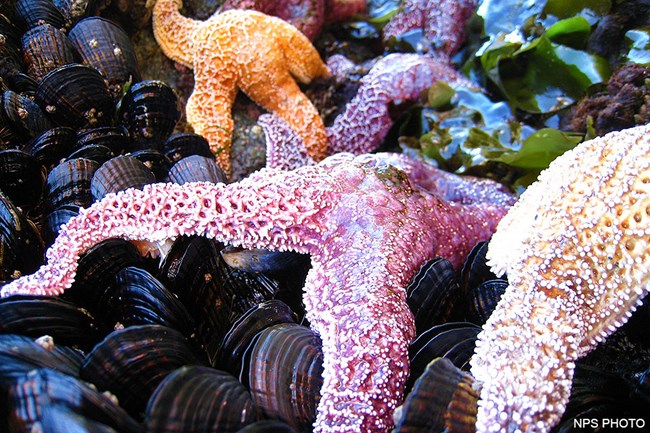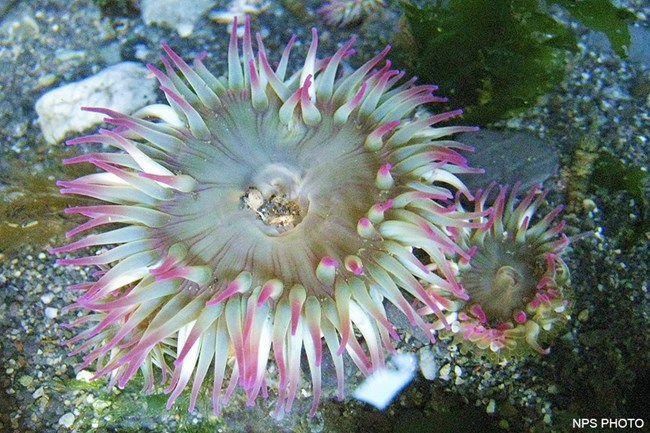
The intertidal area is where the land submerges under the ocean and the tidal zones begin. This complex marine ecosystem is found along coastlines worldwide with general similarities expressed by local diversity. It is a fascinating place to explore and appreciate, especially when accompanied by an understanding of the ecology that holds it together. Imagine being plunged into a washing machine, filled with rocks and icy water, and setting it on the heavy wash cycle. After a few hours in these conditions, you are transferred to an asphalt surface during a heat wave. Repeat every 12 hours and 25 minutes, or so. For those remarkable organisms that call the intertidal zone home, this is similar to what they experience on a daily basis. Along the coast of California, the intertidal zone spans a height of about 2.7 meters (9 feet), which is the extent between the highest high and the lowest low tide. Just 2.7 vertical meters! And yet this predictably precarious margin of damp rocks and turbulent surf is the only place on Earth that many organisms call home. The boundary between surf and turf is a rich landscape, offering many rewards to those who are hearty enough to live there, but life here is not easy. In a matter of hours, a parched and baking landscape shifts to a seascape where frigid and unforgiving waves take control. So, what does it take to live in such a wild location? It seems that most organisms interested in taking up residence take one of two approaches: be tough or be flexible. The Tough GuysWhen faced with battering surf, threats of dehydration and countless creatures looking for an easy lunch, a common adaptation in the intertidal zone is to be tough and don some armor. Many creatures take measures to protect their bodies by having a sturdy protective boundary in the form of an exoskeleton or shell: crabs, barnacles, urchins, snails, limpets, chitons and mussels. Among the armor clad, one of the most steadfast is the mussel. These bivalves are currently being studied by medical researchers who are curious to know how they’re able to remain so firmly attached to the rocks, despite incredible pressure from wave action. It turns out that the mussels are always reinforcing their connection to the rock they call home. As the tide comes in and they’re covered by water the mussel will extend its foot and mend its connection to the rock by producing incredibly powerful strands of protein that appear to the casual tidepooler as hairs. The possibility of studying this remarkable adhesive power and using it for medical purposes is really quite exciting. 
As ingenious as the mussel is at sticking to rocks, it can’t always evade the hungry sea star. Sea stars, a sturdy yet flexible predator, are the tigers of the intertidal zone. When a sea star finds a mussel that seems like it will make a sufficient lunch, it will use its thousands of tube feet to cling to the bivalves shell. Then it pulls. The sea star doesn’t need to pull the shell very far apart, a crack will do. Once an opening has been created, the sea star does something extraordinary: it extrudes its stomach from its body. The sea star will actually push its own stomach into the opening it has made. Digestive processes then go to work, turning the mussel’s flesh into a delicious slurry that the sea star’s stomach can then absorb. Flexible FellowsSome organisms survive the onslaught of the tidal zone by literally going with the flow: alga, sea grasses, sponges, anemones, nudibranchs and octopi. Their supple tissues respond to the impacts of the ocean with ease. For these organisms, the main threat doesn’t come from being battered to pieces, but from drying out—and being eaten, of course. 
The sea anemone solves both of these problems. For the hours between low and high tide, when the threat of dehydration is paramount, anemones are remarkably good at holding onto water. They do this by folding in on themselves, thereby reducing their surface area and opportunity to lose water. Anemones can also be quite adept at cloning themselves. If the threat of being gobbled up is high, it is certainly advantageous to make more than one copy of yourself. In some parts of the intertidal zone, you can find whole rocks simply covered with sea anemones that are all clones of one individual. Then there's the nudibranch. Nudibranchs, sometimes called sea slugs, are the rock stars of the tidepool. It has been said that if the Las Vegas strip were a slug, it'd be a nudibranch. These gastropods come in a wide variety of wildly bright colors and patterns with all manner of strange fronds dangling from them. But these critters aren't just flashy in appearance, they've got style too. A nudibranch can actually eat the arms off a sea anemone, digest part of it, but save the nematocysts (the stinging cells) for another purpose entirely. These astounding creatures actually take the nematocysts, transport them to their skin and repurpose them as stinging cells on their own back. This is roughly analogous to your swallowing a baby porcupine and then growing quills on your back. Some nudibranchs have also been known to repeat this process with chloroplasts from plants. 
Of course, not all organisms that rely on the intertidal zone live there full-time. Birds, foxes, raccoons, bears, and humans all happily enjoy the bounty of food found in the intertidal zone. In fact, there's a saying in virtually every indigenous coastal community that translates to, "When the tide is out, the table is set." As bountiful and mysterious as the intertidal zone is, it's easy to image it standing up to anything life throws its way. But the fact is that the intertidal zone is a delicate place that is very susceptible to changes in climate and environmental quality. It's for this reason that scientists along the entire California coastline are actively engaged in monitoring the intertidal zone over time. As we gather information about what species call the intertidal zone home, we'll be better able to see how this changes over time and what factors are involved in the change. This is a crucial practice if we are to preserve this outstanding ribbon of life that exists where the land and sea intertwine. Learn MoreVisit the Pacific Coast Science and Learning Center's Intertidal Ecosystems page to learn more about the research occurring around the San Francisco Bay Area's intertidal zone. Text for this page was adapted from Adam Smith's June 27, 2008 Science at Point Reyes National Seashore blog entry entitled Rough Living on the California Coast. Science & Research Project SummariesFrom 2006 to 2018, Point Reyes National Seashore and Pacific Coast Science and Learning Center (PCSLC) staff and communication interns assisted scientists conducting research through the PCSLC and the San Francisco Bay Area Inventory & Monitoring Network to produce a series of Resource Project Summaries, two of which was about an inventory of intertidal organisms at Point Reyes. These one- to two-page summaries provide information about the questions that the researchers hoped to answer, details about the project and methods, and the results of the research projects in a way that is easy to understand.
|
Last updated: February 4, 2024
